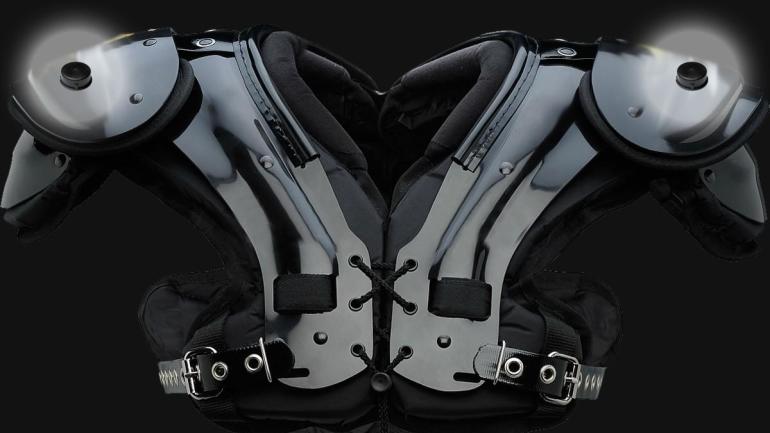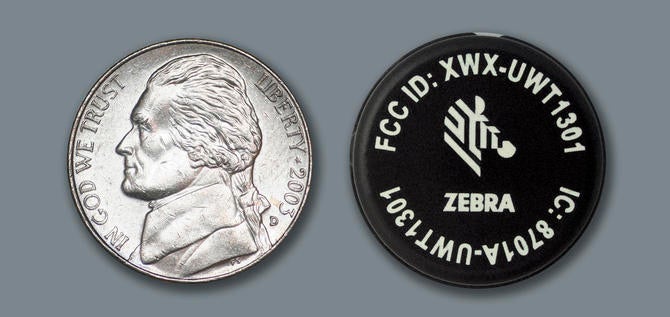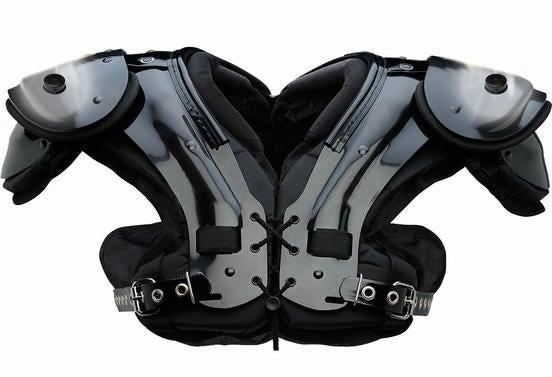
They make footballs at the Wilson factory in Ada, Ohio. And since 2017 they've been making them a little differently for the NFL.
A regulation-sized football weighs 400 grams (please, spare us your Deflategate jokes). Melded into the bladder of the football is a nickel-sized piece of technology that weighs a whole 4 grams. That radio-frequency identification (RFID) tag sends signals to receiver boxes set up in every NFL stadium, and metrics like height and velocity and even RPMs are measured for every single throw of every single game.
Zebra Technologies is entering its eighth season in partnership with the NFL, and the data that ultimately makes the league's Next Gen Stats comes from the tags in the football, individual player shoulder pads, first-down markers and the pylons.
And in reporting this story, what I found is that the future of NFL data collection and analytics is hard to predict.
"Where things can go with the data," says Matt Swensson, the NFL's VP of emerging products and technology, "you can get pretty broad pretty quickly."
Computerized player tracking in the NFL as we know it today is about to enter its teenage years. The league experimented with optical tracking as early as 2009, but it proved too ineffective for wide-scale collection. Following the completion of the 2011 CBA, both the players union and NFL commissioner Roger Goodell showed strong interest in diving into player tracking in earnest. By the 2014 season, the league had partnered with Zebra thanks to its extensive background in RFID technology in retail, manufacturing and warehouse environments.

The evolution and refinement of this data has been rapid. By 2015, all venues that hosted NFL games were equipped with RFID receivers. Balls began getting tagged in 2016, but just for preseason games and Thursday Night Football. Each club then began getting their own game data, and the league started putting more on its front-facing Next Gen Stats website. More advanced stats came in 2017 with the help of Amazon's cloud computing services, and in 2018 the league gave all game data to all clubs each week while implementing the new kickoff rules that prohibited the kicking team from getting a running start after, in part, seeing player speeds from the tags and matching that with concussion data.
It was around that point that John Pollard, Zebra's VP of business development, saw a turning point among fans and media in their collective acceptance of miles-per-hour as a football stat. We became more comfortable with the idea of how fast 19 MPH actually was, and that a quarterback reaching a top speed of 21.23 MPH is really fast.
"Eight to 10 years ago none of us would have thought miles-per-hour was going to be a metric of any consideration in American football," Pollard says. "Within the last two to three years, all the broadcast partners have become much more comfortable and fluent in the tracking data and leveraging it in the process of providing new dimensions to storytelling in a game.
"I'd say over the last two seasons in particular we've worked really closely at trying to find new project opportunities — things I can't talk about today specifically — that we're working on to help support game plan evaluation, game operational processes and team processes as well."
So as to not keep you in suspense throughout this piece, let's go ahead and get this out of the way. If there are markers in the football and pylons and first-down sticks, are we heading for an electronic first down or touchdown?
The answer: potentially, yes. But no time soon.
"Inevitably people consistently ask about ball placement," Pollard says. "Is it feasible that RFID technologies, other technologies, can help support game management processes? Yeah, it's technically feasible. Technology can provide added benefits and there are opportunities for that. What those are, we're still in a period of discovery and consideration. But in terms of accuracy and locationing, we're pretty close."
RFID can be accurate to within 3 or so inches, which is much more accurate than GPS tracking. But it still would need to be more precise in order to dictate what is or isn't a first down in a game like the 2017 Cowboys-Raiders contest where our own Gene Steratore took the unusual step of placing a folded index card at the end of the football to affirm his call.

Plus, the tag in the ball doesn't indicate when a knee or elbow is down. And of course you can't tag body parts on every player. Some sort of optical tracking — like Hawk-Eye in tennis — would be needed in conjunction with the RFID tags in balls and markers.
"I do think it's possible. It's not possible today," Swensson says. "I think it comes through a combination of optical and camera-based feeds with tracking data. And then us getting to a precision level that we're comfortable with. We're just not there yet."
OK, so what is being done? And what can be done? Especially when the league is capturing 200 different metrics per play?
We all can see the front-facing metrics they release on the Next Gen Stats site, and so many of those stats have been integrated into broadcasts and in-stadium videoboards. Rush efficiency measures the total distance a ball-carrier traveled against rushing yards gained (a list a north-south runner like Gus Edwards tops nearly annually.) The Air Yards to Sticks uses the RFID tags in the first-down markers to see how far the ball traveled in relation to the sticks. The passing aggressiveness measurement leverages tags in ball, receiver and defender to see how closely the intended target was covered at the time it was deemed catchable.
But there's a trove of information the media and public does not see. The day after any game, all 32 clubs get a data dump from the previous day's game(s). And they can use the helpful tools provided by the league and/or take the whole lump sum of data and have their employees run their proprietary analytics on it. (The Titans have been the only team in the league without a staffer with "analytics" in their title, though that seems to be changing soon after posting a data analytics position in June.)
"There's two kinds of mechanisms that clubs interact with the data," Swensson says. "There's the raw side where they can take all the information where they have some special tools they've built internally. But then we as a league provide them a tool to go through and see every play. They can scrub through the tracking data synced up with video and can see all the different stats that are generated for that play. And then we have aggregate information, whether at the team or player level, that they can look at as well."
NFL clubs are wildly protective of their analytics departments, but here are some of examples of the possibilities:
- Want to help your pro personnel department? Are your special teams gunners not getting to the returner as quickly as you'd like? Scour the data for some of the league's fastest gunners who may get cut for whatever reason, then pick that player up off waivers.
- Need to reinforce what your quarterback or offensive coordinator is seeing on film, all while making the quality control coach's life a little bit easier? Develop heat maps of defensive player schematic tendencies to show what that safety is doing in a certain down-and-distance situation.
Even the officials are tagged in games to help the league assess their game performance for grading and help with training.
Deciding what to make public versus keeping private is a delicate balance the NFL has to maintain with respect to both competitive edges and the unknowns of sports betting.
"Our goal is to maintain a fair and balanced game and so that's a top priority for us. And that's been true since Day One of this initiative," Swensson says. "And I mentioned how we slow-rolled data not only to our teams but the fans as well. For my team the bar is high when making sure that when we do statistics that the correlations are there. It's statistically and mathematically seeing that this is a true trend and not some anomaly. Because these are the players' careers. A fair game is important to us."

The ball metrics are what have intrigued me the most. The league and its clubs now have four seasons of ball tracking data that includes height, velocity and RPMs. If you were a team with an aging quarterback that happened to be located in, say, New Orleans, you would have been able to track the force with which he was throwing the football throughout the season and over a span of years.
Similarly, if you were a team in Tampa Bay interested in acquiring a free agent quarterback who had spent his entire career in New England and wondered if he still had the juice, you had access to three years' worth of data. (I put in a request with the Buccaneers to see if they did this with Tom Brady, and unsurprisingly I did not hear back one way or the other.)
Pollard calls it a "more guarded approach with that capability." Swensson notes that it's important to understand what narratives may be set off a set of data that could be incomplete. In a sample not large enough, spin rate could give you the style of a play but not necessarily of a player. Could a lower spin rate mean a dead arm or just a more finesse thrower?
All that said, a public-facing ball statistic is in the works in the near future. And the league still has some time to make sure something like that is ready for the season.
"We have a couple of stats that I don't want to reveal them yet and they're still in the works," Swensson says. "There were stats that we were looking to launch in one year and we didn't. And it goes back to your point on how careful we are. We don't do it for the sake of doing it. At this point we have plenty of statistics and content that I think are good for fans to dive into.
"When we're creating a stat, if we don't feel it's ready or has that correlation that we want it to have, we're not going to put it out there. While we work on things around the ball, the speed of the ball and how that might map back to certain style of play or certain outcomes, we just need to cross the Ts and dot the Is."
















